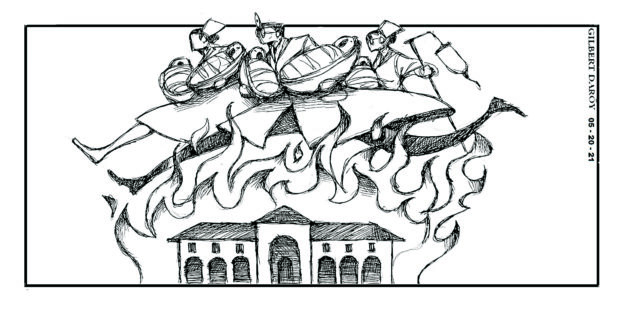SOS for PGH

Editorial cartoon
The fire that struck the Philippine General Hospital (PGH) in the early morning of May 16 could not have come at a worse time for the country’s largest COVID-19 referral facility — in the middle of a yet-uncontained pandemic. The fire started in the supplies room of the operating theaters of the PGH and quickly spread to the other floors, engulfing them in heavy smoke and endangering the lives of patients and hospital personnel alike.
But, thanks to the heroic, quick-witted actions of the nurses, doctors, porters, orderlies, and security staff who went above and beyond their call of duty to rescue patients with no regard for their own safety, no one was hurt and all patients were saved, including fragile newborns who were quickly shuttled to nearby hospitals or taken to the UP PGH Chapel that became an instant medical care facility.
Article continues after this advertisementNight shift nurses Kathrina Bianca Macababbad and Jomar Mallari risked their lives to ensure that all 35 babies in the neonatal intensive care unit on the fourth floor, especially those in critical condition and intubated, were evacuated to safety and properly tagged to avoid baby-switching. The pair went in and out of the smoke-filled third floor to rush the infants out. “Di ko alam saan nanggaling iyon pero wala akong naramdamang takot sa dibdib ko—thank you Lord for the unwavering strength and courage,” said Macababbad, recounting their experience in a now-viral Facebook post.
Dr. Jhing Talan likewise witnessed how hospital heads, chief residents, nurses, residents, and fellows selflessly pitched in to shepherd all patients from the third to the seventh floors to safety. Nurses and nurse aides lugged bottles of IV fluids for the continued hydration of patients and tracked their flow into the parking lot to make sure everyone was evacuated from the higher floors.
“Posting this to remind myself in the years to come that people are really good at heart, and tragedies like this make us show our true selves,” said Talan.
Article continues after this advertisementThe full extent of the damage is still being assessed, but PGH Director Dr. Gerardo Legaspi said it would not be lower than P50 million as some of the equipment lost cost P1 million to P3 million per set. The hardest hit were the hospital’s operating room and supply and autoclave rooms where some of the operating equipment were washed, sterilized, and kept. The loss of the equipment, said Legaspi, would “severely affect us.”
With 1,500 beds, of which an estimated 67 percent are occupied by the poor, the 114-year-old PGH serves about 600,000 patients every year. The harrowing blow against the country’s go-to indigent facility immediately set off calls for donations and help in various kinds. Among the first to respond was Vice President Leni Robredo, who at 4 a.m. that Sunday called on those with large industrial fans to lend them to the hospital to get rid of the smoke that had enveloped its floors. Hanabishi Corp. immediately responded to Robredo’s appeal. GCash of Globe Telecom and Shopee also set up their own donation portals to gather funds for the PGH.
Presidential spokesperson Harry Roque’s initial reaction to the accident was to say that the Palace was “saddened” by the fire and to thank the public “for immediately responding to the call for emergency donations of the PGH.”
Some lawmakers were moved to revisit the issue of adequate funding, which the PGH has sought every year. Describing the accident as a “double calamity”, Sen. Joel Villanueva called on the administration to tap the P19.445-billion unused 2020 and 2021 calamity funds for the “building back [of] a better and bigger PGH.”
Gabriela party list Rep. Arlene Brosas sought the realignment of a portion of the P1.1-trillion funds under the “Build, build, build” program for the immediate reconstruction of the PGH, which, she pointed out, was “financially constrained” to do building and equipment repairs following the fire since “there is zero allocation for such under the 2021 national budget.”
The PGH’s budget has long been fought over. In 2020, lawmakers cut its allocation by more than P400 million before half of it was restored in the final version. This year, with the COVID-19 pandemic, the PGH received extra funding of P1.54 billion — still all too meager in comparison to the budget allocated for the anti-insurgency and infrastructure programs and the intelligence funds of the Office of the President. As Sen. Ralph Recto put it: “Funding for [PGH] is the national barometer of our health priorities. It is the national hospital, so the money it gets from the government reflects the importance [the] government gives to health.”
More than expressing sadness and foisting on the public the duty to lend a hand, the Palace’s task is to do everything in its power to do right by the PGH. It may have escaped disaster, but it needs all the help it can get, above all from the national government that has chronically given it short shrift.















